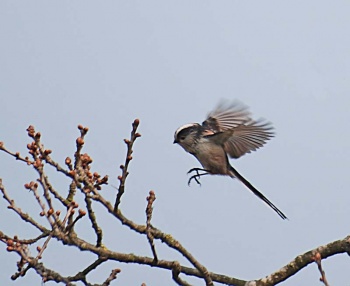Alternative name: Long-tailed Bushtit
- Aegithalos caudatus
Identification
24–27 cm (9½-10½ in), weight 6-10 g
Very often will give the impression of a small fluffy circular ball with a long tail attached; more than half its length constitutes its 6-10 cm tail. Black and rosy-beige to greyish above and white below, with rosy-beige to greyish flanks. It has a white crown but different subspecies differs in amount of black in head. The different subspecies also differ in tail length, with northern populations having longer tails. The bill is very short.
Juvenile of all subspecies is darker and less glossy, with a broad dusky brown band through and behind the eye, and lacks rosy colours; right after fledging, the tail is also shorter.
Distribution
Europe and Asia but not in tropical areas.
Taxonomy
Silver-throated Tit was formerly included in this species.
Subspecies
Seventeen subspecies in four subspecies groups are recognised[1]:
- A. c. caudatus group: white head; body black, white and bright pink. North of Europe and Asia.
- A. c. europaeus group: head white with blackish eyebrows; body black, white and dull pink. Temperate Europe.
- A. c. rosaceus: British Isles
- A. c. aremoricus: western France, Channel Islands and Île d'Yeu
- A. c. taiti: southern and southwestern France to northwestern Spain and Portugal
- A. c. europaeus: eastern France and Germany to northern Italy, western Romania and northern Bulgaria
- A. c. macedonicus: Albania, Yugoslavia, Greece and southern Bulgaria
- A. c. tauricus: southern Crimean Peninsula
- A. c. alpinus group: head white with blackish eyebrows; body grey and dull white, little or no pink tones; tail shorter. Mediterranean region.
- A. c. irbii: southern Spain, Portugal and Corsica
- A. c. italiae: Mainland Italy and Yugoslavia
- A. c. siculus: Sicily
- A. c. tephronotus: Asia Minor
- A. c. major: Caucasus to western and central Transcaucasia
- A. c. alpinus: southeastern Azerbaijan to northern Iran and southwestern Turkmenistan
- A. c. passekii: Zagros Mountains (sw Iran)
- A. c. trivirgatus group: head white with blackish eyebrows; body black, white and dull pink. East Asia.
Habitat
Deciduous woodlands with undergrowth, scrub and other bushy habitats; also common in parks and gardens. Also wetland reed beds.
Behaviour
Flight
Flight is short, whirring bursts and drops. Looks like a bouncing ball of fluff with a tail. Usually in flocks playing follow-my-leader from one patch of cover to another. Seldom stays still for long, flitting about within a bush, chasing insects.
Breeding
Woven nests containing spiders' webs and lichen are built in a tree or shrub. Up to a dozen eggs per clutch.
Diet
Diet includes insects, spiders and (mainly in winter) small seeds. Increasingly often visiting bird feeders in gardens, even in urban areas.
Vocalisation
References
- Clements, J. F., T. S. Schulenberg, M. J. Iliff, D. Roberson, T. A. Fredericks, B. L. Sullivan, and C. L. Wood. 2018. The eBird/Clements checklist of birds of the world: v2018. Downloaded from http://www.birds.cornell.edu/clementschecklist/download/
- Wikipedia contributors. (2019, February 7). Long-tailed tit. In Wikipedia, The Free Encyclopedia. Retrieved 07:22, April 21, 2019, from https://en.wikipedia.org/w/index.php?title=Long-tailed_tit&oldid=882238797
- Beaman, M., Madge, S., & Olsen, K. M. (1998). Fuglene i Europa, Nordafrika og Mellemøsten. Copenhagen, Denmark: Gads Forlag, ISBN 87-12-02276-4
- Harrap, S. (2019). Long-tailed Tit (Aegithalos caudatus). In: del Hoyo, J., Elliott, A., Sargatal, J., Christie, D.A. & de Juana, E. (eds.). Handbook of the Birds of the World Alive. Lynx Edicions, Barcelona. (retrieved from https://www.hbw.com/node/59741 on 16 April 2019).
- Hatchwell, B.J., D. J. Ross, M. K. Fowlie, A. McGowan (2001) Kin discrimination in cooperatively breeding long–tailed tits 268 Proceedings of the Royal Society of London. Series B: Biological Sciences. https://doi.org/10.1098/rspb.2001.1598
- Sharp, S.P., Simeoni, M. & Hatchwell, B.J. (2008) Dispersal of sibling coalitions promotes helping among immigrants in a cooperatively breeding bird. 275. Proceedings of the Royal Society B: Biological Sciences http://doi.org/10.1098/rspb.2008.0398
Recommended Citation
- BirdForum Opus contributors. (2025) Long-tailed Tit. In: BirdForum, the forum for wild birds and birding. Retrieved 26 April 2025 from https://www.birdforum.net/opus/Long-tailed_Tit
External Links
GSearch checked for 2020 platform.1








